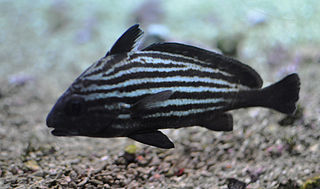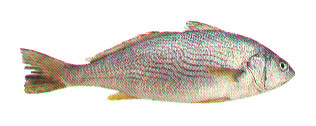
Sciaenidae is a family of ray-finned fishes belonging to the order Acanthuriformes. They are commonly called drums or croakers in reference to the repetitive throbbing or drumming sounds they make. The family consists of about 293 to 298 species in about 66 or 67 genera.

Menticirrhus is a genus of marine ray-finned fish belonging to the family Sciaenidae, the drums or croakers. They are commonly known as kingcroakers or kingfish. These fish are found in the Western Atlantic and Eastern Pacific Oceans.

Micropogonias is a genus of marine ray-finned fishes belonging to the family Sciaenidae, the drums and croakers. These fishes are found in the eastern Pacific and western Atlantic Oceans.

Pogonias is a genus of ray-finned fish in the family Sciaenidae. It was formerly believed to be a monotypic genus only containing the black drum, but a second species was re-described in 2019.

The spotted drum or spotted ribbonfish, is a species of marine ray-finned fish belonging to the family Sciaenidae, the drums and croakers. This species is found in the western Atlantic Ocean.

Cynoscion is a genus of marine ray-finned fishes belonging to the family, Sciaenidae, the drums and croakers. These fishes are found off the coasts of North and South America in the western Atlantic and eastern Pacific Oceans. Many fishes in this genus have been given the common name weakfish.

The jack-knifefish is a species of marine ray-finned fish belonging to the family Sciaenidae, the drums and croakers. It is native to the western Atlantic Ocean, where its distribution extends along the eastern coasts of the Americas from the Carolinas in the United States to Brazil, including the Caribbean. Other common names include donkey fish and lance-shaped ribbonfish.

Pareques acuminatus, commonly known as the high-hat, donkeyfish, cubbyu, Steindachner's ribbonfish, streaked ribbonfish, striped ribbonfish or striped drum, is a species of marine ray-finned fish belonging to the genus Pareques in the family Sciaenidae, the drums and croakers. This species is found in the western Atlantic Ocean.

Corvula is a genus of marine ray-finned fishes belonging to the family Sciaenidae, the drums and croakers. These fishes are found in the western Atlantic Ocean and the central eastern Pacific Ocean.

Bairdiella is a genus of marine ray-finned fishes belonging to the family Sciaenidae, the drums and croakers. These fishes are found in the western Atlantic and eastern Pacific Ocean.

Umbrina is a genus of fish from the croaker family Sciaenidae. The genus contains 17 species occurring in tropical and warm temperate waters of the Atlantic, the Mediterranean, the Western Indian Ocean and the eastern Pacific.

Atractoscion is a genus of marine ray-finned fished belonging to the family Sciaenidae, the drums and croakers. The fishes in this genus are found in the Atlantic, Indian and Pacific Oceans.

Pareques is a genus of marine ray-finned fishes belonging to the family Sciaenidae, the drums and croakers. These fishes are found in the western Atlantic Ocean and eastern Pacific Ocean.

Lonchurus is a genus of marine ray-finned fishes belonging to the family Sciaenidae, the drums and croakers. These fishes are found in the Western Atlantic.
Ctenosciaena is a genus of marine ray-finned fishes belonging to the family Sciaenidae, the drums and croakers. These fishes are found in the Western Atlantic and southeastern Pacific Oceans.
The bluestreak drum, also known as the bluish croaker, is a species of marine ray-finned fish belonging to the family Sciaenidae, the drums and croakers. It is the only species in the monospecific genus Elattarchus. This species is found in the central eastern Pacific Ocean along the coasts of the Americas.

Johnius dussumieri, the sin croaker, Dussumier's croaker, Dussumier's silver jewfish, sharptooth hammer croaker or whiskered croaker, is a marine ray-finned fish belonging to the family Sciaenidae, the drums and croakers. This fish is found in the Indian Ocean.

Johnius carutta, the karut croaker or purple jewfish, is a species of marine ray-finned fish belonging to the family Sciaenidae, the drums and croakers. This species is found in the western Indian Ocean.
Paralonchurus is a genus of marine ray-finned fishes belonging to the family Sciaenidae, the drums and croakers. These fishes are found in the eastern Pacific Ocean with one species in the western Atlantic Ocean.
Protosciaena is a small genus of marine ray-finned fishes belonging to the family Sciaenidae, the drums and croakers. These fishes are found in the Western Atlantic Ocean.















